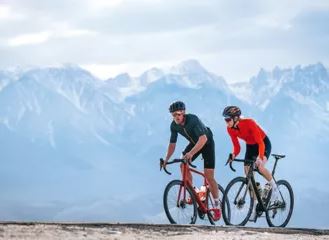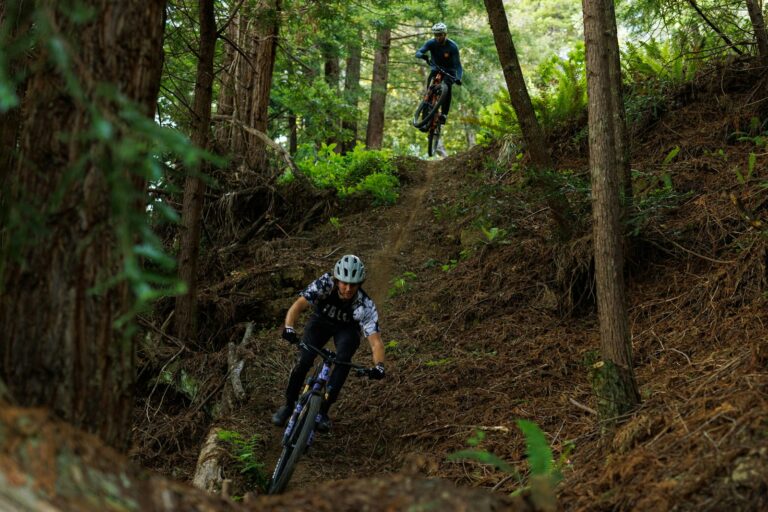Gravel Bike Buyers Guide

With the rise in popularity of gravel biking, there’s been a surge of options flooding the market, catering to both seasoned riders like me and beginners alike. Whether you’re a thrill-seeker wanting to race down rugged terrains or simply a commuter desiring versatility for urban and off-road paths, choosing the right gravel bike can be a game-changer. But with so many factors to consider – from frame material to gearing, wheel size, and even budget – where do you start?
Dive into our comprehensive Gravel Bike Buyers Guide, where we break down the essentials, provide insights into the nuances, and guide you step by step to ensure your next purchase perfectly matches your cycling ambitions.
For the record, I ride a Canyon Grizl with a 1x setup and a dropper post.
1. Purpose
- Gravel Racing: If participating in events, you’ll want something efficient, lightweight, with a more aggressive riding position.
- Mixed-Terrain Commuting: Consider fender and rack mounts for carrying goods and protection from splashes.
2. Frame Material
- Aluminum: Modern aluminum frames are made with hydroforming techniques to shape the tubes, offering better strength-to-weight ratios and compliance.
- Carbon Fiber: Known for vibration damping, which reduces fatigue on long, rough rides. if you can afford carbon, this is the way to go.
3. Wheel Size
- 700c: Typically paired with 28mm to 42mm tires, although some newer frames allow even wider.
4. Tire Clearance
- Tread Pattern: For muddy conditions, go for aggressive treads. For mixed or dry conditions, a semi-slick might be best. I own two sets of Gravel Bike Tires and change them out based on the terrain I’m riding.
5. Gearing
- Cassette Range: With 1x setups, an 11-42 or 10-50 range is common. For 2x, 11-32 or 11-34 paired with compact chainrings offers versatility.
6. Brakes
- Hydraulic vs. Mechanical: Hydraulic disc brakes offer better modulation and require less hand strength. Mechanical disc brakes are easier to maintain on long trips where professional service might not be available.
7. Geometry
- Stack and Reach: These are measurements that can give you an idea of a bike’s aggressiveness. Higher stack and shorter reach are more relaxed, while a lower stack and longer reach are more aggressive.
8. Suspension
- Tuning: If choosing a bike with suspension, ensure it’s tunable to your weight and riding style.
9. Attachment Points
- Frame Bags: Even without mounts, many riders opt for frame bags that strap directly onto the bike, providing storage without the need for racks.
10. Budget
- Used Bikes: Don’t shy away from the used market. Many cyclists take great care of their bikes, and you might find a gem for a fraction of its original price. Below are links to my favorite used Bike Resources.
- The Pro’s Closet
- Pinkbike
11. Test Ride
- Saddle Comfort: During the test ride, pay attention to the saddle. It’s one of the primary contact points and can make or break your riding experience.
12. Brands
- Emerging Brands: Apart from big names, consider emerging brands or local builders who might offer unique designs or customization. Below are links to some of the new and upcoming Gravel Bike Brands.
- Parlee Cycles
- Stradalli
- Wilier
- Norco
- Moots
- Marin
13. Accessories
- Clothing: One of the biggest differences between road, mountain, and gravel cultures is clothing. The gravel scene focuses more on earth tones than the road scene. Invest in a good pair of padded shorts or bibs. Gravel-specific shoes offer a good balance between stiffness for pedaling efficiency and flexibility for walking.
Remember that personal comfort and fit are paramount. Reviews, specifications, and advice are beneficial, but your experience on the bike is the ultimate deciding factor.
Conclusion:
Choosing the perfect gravel bike can initially seem overwhelming given the many options and considerations. However, you can narrow down the options by understanding your primary usage, setting a clear budget, and weighing the various features against your needs. Remember that while technical specs and brand reputations offer valuable guidance, the ultimate test is how the bike feels beneath you. It’s a personal journey, and the right choice will be the one that sparks excitement, feels comfortable, and meets your specific requirements. As you embark on this adventure, remember that each ride, whether on gravel or pavement, is not just about the destination but the experience along the way.
I hope you enjoyed this Gravel Bike Buyers Guide! John
Click here to Access our Best Gravel Bikes ranked and rated.
FAQ’s
What size gravel bike for my height?
To determine the best gravel bike size for your height, you’ll first need to know your height and your inseam length. Generally, bike sizes are determined by the frame size (measured in centimeters for road bikes and sometimes in inches for mountain bikes) and are based on the length of the seat tube.
Here’s a general guideline for gravel bike sizing based on height:
Gravel Bike Sizing Chart:
| Rider Height (ft/in) | Rider Height (cm) | Bike Frame Size (cm) |
|---|---|---|
| 5’0″ – 5’3″ | 152 – 160 | 49 – 51 |
| 5’3″ – 5’6″ | 160 – 168 | 51 – 53 |
| 5’6″ – 5’9″ | 168 – 175 | 54 – 55 |
| 5’9″ – 6’0″ | 175 – 183 | 56 – 58 |
| 6’0″ – 6’3″ | 183 – 191 | 58 – 61 |
| 6’3″ – 6’6″ | 191 – 198 | 61 – 63 |
However, there are a few important things to note:
- Inseam Length: This is arguably more critical than height. Two people can be 6’0″, but if one has longer legs and the other a longer torso, they might need different frame sizes. Generally, you want enough standover height so that when you stand over the bike, there’s at least an inch of clearance between your crotch and the top tube.
- Geometry: Gravel bikes come in various geometries, from race-oriented to more relaxed. Depending on the bike’s purpose and your preference (racing, long rides, commuting), you might choose a different size.
- Test Ride: If possible, always test ride a bike before buying. This is the best way to know if a bike fits you. A bike shop can also help in adjusting saddle height, saddle position, and handlebar height to make the bike fit better.
- Adjustments: Remember, even after selecting the right frame size, you’ll likely need to make some adjustments for the perfect fit. This might include changing the saddle, adjusting its position, or swapping the stem.
- Brands Vary: Sizing can vary between brands, so it’s always good to check the specific brand’s size chart or consult with the manufacturer or bike shop.
Should I get a larger or smaller frame gravel bike?
Choosing between a larger or smaller frame for a gravel bike depends on several factors, including your riding style, comfort preferences, and the specific bike’s geometry. Here are some considerations to help you decide:
Advantages of a Larger Frame:
- Stability: A larger frame might offer more stability, especially at higher speeds, due to a longer wheelbase.
- Comfort: A larger frame can provide a more comfortable ride over long distances since it might distribute road vibrations more effectively across a bigger surface area.
- Room for Adjustments: A larger frame will typically give you more space to adjust the saddle height and position.
Advantages of a Smaller Frame:
- Maneuverability: A smaller frame tends to be more agile and responsive, which can be beneficial on technical terrains or tight corners.
- Weight: Smaller frames are generally lighter, which might help if you’re aiming to reduce the overall bike weight.
- Standover Height: A smaller frame will provide more clearance when you stand over the bike, which can be crucial if you need to quickly dismount on unpredictable terrains.
- Aggressive Position: For those who prefer a more aggressive riding position, a smaller frame can facilitate that.
General Tips:
- Test Ride: If you’re between sizes, the best approach is to test ride both sizes, if possible. Riding the bike will give you a better feel than just looking at specs or standing over it in the shop.
- Geometry: Remember that bike sizing isn’t just about the height of the frame. The top tube length, reach, and stack are significant geometry factors that can influence how a bike fits.
- Adjustments: Both larger and smaller frames offer adjustment possibilities. For a larger frame, you might need a shorter stem to bring the handlebars closer. For a smaller frame, a longer stem or seat post might be required.
- Consult with Experts: It’s always good to consult with a bike shop or expert, especially if you’re new to gravel biking or if you have unique fitting requirements.
Bottom Line: If you’re truly stuck between sizes and can’t test ride, many riders opt for the smaller size for gravel bikes due to the added maneuverability and the easier adjustments (like adding a longer stem or seat post). However, the best choice will always depend on your personal preferences and riding style.
How do I know if my gravel bike fits me?
Ensuring a proper fit for your gravel bike is crucial for comfort, efficiency, and injury prevention. Here are several indicators and tests to determine if your gravel bike fits you properly:
- Saddle Height: When you sit on the saddle with your heel on the pedal (which should be at its lowest point), your leg should be straight. If your hips are rocking side to side while pedaling, the saddle might be too high. If your knee is significantly bent, it might be too low.
- Saddle Fore/Aft Position: When the pedal is at the 3 o’clock position (horizontal), a plumb line dropped from the front of your kneecap should intersect the pedal axle. Adjust the saddle forward or back to achieve this alignment.
- Saddle Tilt: Your saddle should be level or slightly tilted up or down based on personal comfort. An improperly tilted saddle can cause discomfort or pressure points.
- Handlebar Height: For gravel bikes, many riders prefer handlebars level with or slightly above the saddle’s height. This provides a more upright, comfortable position, especially on long rides. However, some might prefer a lower position for a more aggressive posture.
- Handlebar Reach: When you’re on the bike with your hands on the brake hoods or tops, your elbows should have a slight bend (about a 10°-30° angle). If you feel stretched out or too cramped, you might need to adjust the stem length or angle.
- Standover Height: There should be an inch or two (2.5 to 5 cm) of clearance between you and the top tube when you stand flat-footed over the bike.
- Foot Position on the Pedal: The ball of your foot should be directly over the pedal spindle. This might require adjusting the cleat position if you’re using clipless pedals.
- Knee Alignment: While pedaling, your knees should move up and down in a straight line, not veering in or out. Saddle width, cleat position, or even pedal choice can affect this.
- Comfort: While technical measurements are important, your comfort is crucial. Pay attention to any discomfort, numbness, or pain in areas like your wrists, back, neck, or buttocks. These could be signs of an improper fit.
- Test Ride: Take the bike for a longer ride. Short spins around the shop won’t necessarily reveal fit issues that become apparent after an hour or more on the bike.
- Consult a Professional: Consider getting a professional bike fitting. Expert fitters will analyze your riding style, flexibility, and anatomy to fine-tune your bike’s fit, optimizing comfort and performance.
Remember, while there are general guidelines for bike fitting, everyone’s body is different. It’s essential to make adjustments based on your unique anatomy and riding style.






